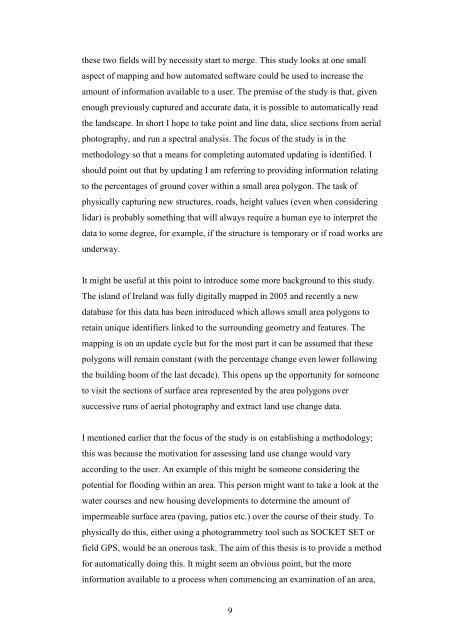You also want an ePaper? Increase the reach of your titles
YUMPU automatically turns print PDFs into web optimized ePapers that Google loves.
these two fields will by necessity start to merge. This study looks at one small<br />
aspect of mapping and how automated software could be used to increase the<br />
amount of information available to a user. The premise of the study is that, given<br />
enough previously captured and accurate data, it is possible to automatically read<br />
the landscape. In short I hope to take point and line data, slice sections from aerial<br />
photography, and run a spectral analysis. The focus of the study is in the<br />
methodology so that a means for completing automated updating is identified. I<br />
should point out that by updating I am referring to providing information relating<br />
to the percentages of ground cover within a small area polygon. The task of<br />
physically capturing new structures, roads, height values (even when considering<br />
lidar) is probably something that will always require a human eye to interpret the<br />
data to some degree, for example, if the structure is temporary or if road works are<br />
underway.<br />
It might be useful at this point to introduce some more background to this study.<br />
The island of Ireland was fully digitally mapped in 2005 and recently a new<br />
database for this data has been introduced which allows small area polygons to<br />
retain unique identifiers linked to the surrounding geometry and features. The<br />
mapping is on an update cycle but for the most part it can be assumed that these<br />
polygons will remain constant (with the percentage change even lower following<br />
the building boom of the last decade). This opens up the opportunity for someone<br />
to visit the sections of surface area represented by the area polygons over<br />
successive runs of aerial photography and extract land use change data.<br />
I mentioned earlier that the focus of the study is on establishing a methodology;<br />
this was because the motivation for assessing land use change would vary<br />
according to the user. An example of this might be someone considering the<br />
potential for flooding within an area. This person might want to take a look at the<br />
water courses and new housing developments to determine the amount of<br />
impermeable surface area (paving, patios etc.) over the course of their study. To<br />
physically do this, either using a photogrammetry tool such as SOCKET SET or<br />
field GPS, would be an onerous task. The aim of this thesis is to provide a method<br />
for automatically doing this. It might seem an obvious point, but the more<br />
information available to a process when commencing an examination of an area,<br />
9
















